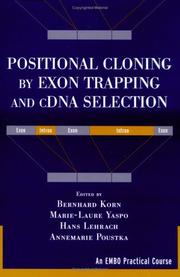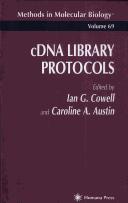| Listing 1 - 7 of 7 |
Sort by
|
Book
Year: 2002 Publisher: Bruxelles: UCL,
Abstract | Keywords | Export | Availability | Bookmark
 Loading...
Loading...Choose an application
- Reference Manager
- EndNote
- RefWorks (Direct export to RefWorks)
Theiler’s virus is a murine picornavirus causing chronic infections of the central nervous system. The 2A protein of this virus is 134 amino acid-long. The C-terminal 18 amino acids of this protein are involved in co-translational processing of the polyprotein encoded by the virus. The N-terminal part of the protein diverges from the 2A proteins of other picornaviruses and shares no clear similarity with any known protein. Theiler’s virus mutants carrying deletions in the 2A region showed abnormal processing of the L-capsid-2A protein precursor.
The aim of this work was to analyze revertant viruses selected previously from such 2A deletion mutants. We obtained infectious viral cDNA clones carrying the capsid-2A and/or the VP1-2A region of two 2A revertants. The sequence of these viruses and the analysis of recombinant viruses constructed from these clones indicated that mutations within the 2A sequence were primarily responsible for the “revertant” phenotype. These reversion mutations likely restore the processing defect of the L-capsid-2A protein precursor, which was detected in the 2A deletion mutants Le virus de Theiler est un picornavirus responsable d’infections persistantes du système nerveux central de la souris. La protéine 2A de ce virus est l’une des protéines les moins bien connues du point de vue de sa fonction dans le cycle viral. Nous savons que l’extrémité C-terminale de cette protéine est impliquée dans le clivage co-traductionnel de la polyprotéine codée par le virus, au niveau de la jonction 2A/2B. Le rôle du reste de la protéine 2A reste inconnu. Des mutants du virus de Theiler contenant des délétions introduites dans la région 2A subissent un clivage anormal de la protéine précurseur L-capside-2A. Une série de révertants ont été isolés précédemment au laboratoire à partir de tels mutants.
L’objectif de ce travail était de cloner et de caractériser le génome de ces révertants. Nous avons obtenu et analysé des clones de virus infectieux comportant les régions capside-2A et/ou VP1-2A de deux de ces révertants. La séquence de ces virus et l’analyse de virus recombinants indique que les réversions sont dues principalement à des mutations survenues dans la région 2A. Il est vraisemblable que ces mutations compensent les problèmes de « processing » des protéines précurseurs de la capside décelés dans les mutants de délétions 2A
Book
Year: 2013 Publisher: Bruxelles: UCL,
Abstract | Keywords | Export | Availability | Bookmark
 Loading...
Loading...Choose an application
- Reference Manager
- EndNote
- RefWorks (Direct export to RefWorks)
Glutamic Acid --- DNA, Complementary --- Plasmids --- Caspase 3

ISBN: 0471297976 Year: 1999 Publisher: Heidelberg : New York, NY : SPEKTRUM [Elsevier], John Wiley,
Abstract | Keywords | Export | Availability | Bookmark
 Loading...
Loading...Choose an application
- Reference Manager
- EndNote
- RefWorks (Direct export to RefWorks)
Gene amplification. --- DNA, Complementary. --- Exons --- Polymerase chain reaction

ISBN: 0121822044 Year: 1999 Volume: 303 Publisher: New York, NY ; London : Academic Press,
Abstract | Keywords | Export | Availability | Bookmark
 Loading...
Loading...Choose an application
- Reference Manager
- EndNote
- RefWorks (Direct export to RefWorks)
C DNA --- DNA [Complementair ] --- DNA [Complementary ] --- DNA [Complémentaire ] --- Gene expression. --- Dna formation --- Genetic information --- Translation, genetic
Dissertation
ISBN: 9036712505 Year: 2000 Publisher: [S.l.] [s.n.]
Abstract | Keywords | Export | Availability | Bookmark
 Loading...
Loading...Choose an application
- Reference Manager
- EndNote
- RefWorks (Direct export to RefWorks)
DNA Primers --- DNA, Complementary --- Biomarkers, Tumor --- Neoplasms --- chemical synthesis --- analysis. --- therapy --- Theses --- analysis
Book
ISBN: 1617790656 1617790648 9781617790645 Year: 2011 Publisher: Totowa, NJ : Humana Press : Imprint: Humana,
Abstract | Keywords | Export | Availability | Bookmark
 Loading...
Loading...Choose an application
- Reference Manager
- EndNote
- RefWorks (Direct export to RefWorks)
The numerous vital applications of complementary DNA (cDNA) technology have changed dramatically as the technology has advanced over recent years. In cDNA Libraries: Methods and Protocols, expert researchers provide current techniques that reflect the latest advances in the construction and application of cDNA libraries. The first half of the volume covers improved approaches to some of the most basic elements of creating cDNA libraries, while the second half casts a much wider net and includes visionary applications of cDNA technology which were either unforeseen or technically impractical until recently. Written in the highly successful Methods in Molecular Biology™ series format, chapters include introductions to their respective topics, lists of the necessary materials and reagents, step-by-step, readily reproducible laboratory protocols, and key tips on troubleshooting and avoiding known pitfalls. Authoritative and cutting-edge, cDNA Libraries: Methods and Protocols serves as an ideal guide to all scientists seeking to advance this important technology and provide answers to the enduring fundamental questions of biology.
Antisense DNA --- Publication Formats --- Genetic Structures --- Genetic Phenomena --- Publication Characteristics --- Phenomena and Processes --- Laboratory Manuals --- Gene Library --- Human Anatomy & Physiology --- Health & Biological Sciences --- Animal Biochemistry --- DNA, Complementary --- Antisense nucleic acids --- Acides nucléiques antisens --- DNA Library --- cDNA Library --- DNA Libraries --- Gene Libraries --- Libraries, DNA --- Libraries, Gene --- Libraries, cDNA --- Library, DNA --- Library, Gene --- Library, cDNA --- cDNA Libraries --- Genetic Concepts --- Genetic Phenomenon --- Genetic Process --- Genetic Processes --- Concept, Genetic --- Concepts, Genetic --- Genetic Concept --- Phenomena, Genetic --- Phenomenon, Genetic --- Process, Genetic --- Processes, Genetic --- Genetic Structure --- Structure, Genetic --- Structures, Genetic --- Complementary DNA --- DNA, Complementary. --- Human genetics. --- Gene expression. --- Human Genetics. --- Gene Expression. --- Genes --- Genetic regulation --- Genetics --- Heredity, Human --- Human biology --- Physical anthropology --- Expression

ISBN: 089603383X 9786610836765 1280836768 1592595553 Year: 1997 Volume: 69 Publisher: Totowa, NJ : Humana Press : Imprint: Humana,
Abstract | Keywords | Export | Availability | Bookmark
 Loading...
Loading...Choose an application
- Reference Manager
- EndNote
- RefWorks (Direct export to RefWorks)
The first libraries of complementary DNA (cDNA) clones were con structed in the mid-to-late 1970s using RNA-dependent DNA polymerase (reverse transcriptase) to convert poly A* mRNA into double-stranded cDNA suitable for insertion into prokaryotic vectors. Since then cDNA technology has become a fundamental tool for the molecular biologist and at the same time some very significant advances have occurred in the methods for con structing and screening cDNA libraries. It is not the aim of cDNA Library Protocols to give a comprehensive review of all cDNA library-based methodologies; instead we present a series of up-to-date protocols that together should give a good grounding of proce dures associated with the construction and use of cDNA libraries. In deciding what to include, we endeavored to combine up-to-date versions of some of the most widely used protocols with some very usefiil newer techniques. cDNA Library Protocols should therefore be especially useful to the investigator who is new to the use of cDNA libraries, but should also be of value to the more experienced worker. Chapters 1—5 concentrate on cDNA library construction and manipula tion, Chapters 6 and 7 describe means of cloning difficult-to-obtain ends of cDNAs, Chapters 8-18 give various approaches to the screening of cDNA libraries, and the remaining chapters present methods of analysis of cDNA clones including details of how to analyze cDNA sequence data and how to make use of the wealth of cDNA data emerging from the human genome project.
DNA, Complementary --- Gene Library --- Genetic Techniques --- Antisense DNA --- DNA --- Gene libraries --- Molecular cloning --- ADN --- Clonage moléculaire --- Laboratory manuals --- Manuels de laboratoire --- 57.088 --- 577.212.3 --- -DNA --- -Gene libraries --- -Molecular cloning --- -#ABIB:aimm --- Cloning, Molecular --- DNA cloning --- Gene cloning --- Cloning --- Genetic engineering --- Molecular genetics --- Clone cells --- Gene banks (Genetic engineering) --- Genomic banks --- Genomic libraries --- Biological resource centers --- Genomes --- Recombinant DNA --- Deoxyribonucleic acid --- Desoxyribonucleic acid --- Thymonucleic acid --- TNA (Nucleic acid) --- Deoxyribose --- Nucleic acids --- Genes --- Complementary DNA --- Antisense nucleic acids --- Special methods and techniques for studing biological molecules. Separation. Centrifuging. X-ray study. Radioisotope methods --- Nucleic acid base and sequence compositon. Experimental deciphering of genetic code. --- Antisense DNA -- Laboratory manuals. --- DNA -- Laboratory manuals. --- Electronic books. -- local. --- Gene libraries -- Laboratory manuals. --- Molecular cloning -- Laboratory manuals. --- DNA, Single-Stranded --- DNA Probes --- Genetic Structures --- Investigative Techniques --- Nucleic Acid Probes --- Analytical, Diagnostic and Therapeutic Techniques and Equipment --- Genetic Phenomena --- Nucleic Acids --- Phenomena and Processes --- Molecular Probes --- Laboratory Chemicals --- Nucleic Acids, Nucleotides, and Nucleosides --- Chemicals and Drugs --- Specialty Uses of Chemicals --- Chemical Actions and Uses --- Genetics --- Biology --- Health & Biological Sciences --- DNA, Complementary. --- Gene Library. --- Genetic Techniques. --- Laboratory manuals. --- 577.212.3 Nucleic acid base and sequence compositon. Experimental deciphering of genetic code. --- 57.088 Special methods and techniques for studing biological molecules. Separation. Centrifuging. X-ray study. Radioisotope methods --- Antisense dna --- Dna --- Dna, complementary. --- Gene library. --- Genetic techniques. --- Clonage moléculaire --- #ABIB:aimm --- Nucleic acid base and sequence compositon. Experimental deciphering of genetic code --- Cytology. --- Immunology. --- Cell Biology. --- Immunobiology --- Life sciences --- Serology --- Cell biology --- Cellular biology --- Cells --- Cytologists
| Listing 1 - 7 of 7 |
Sort by
|

 Search
Search Feedback
Feedback About
About Help
Help News
News